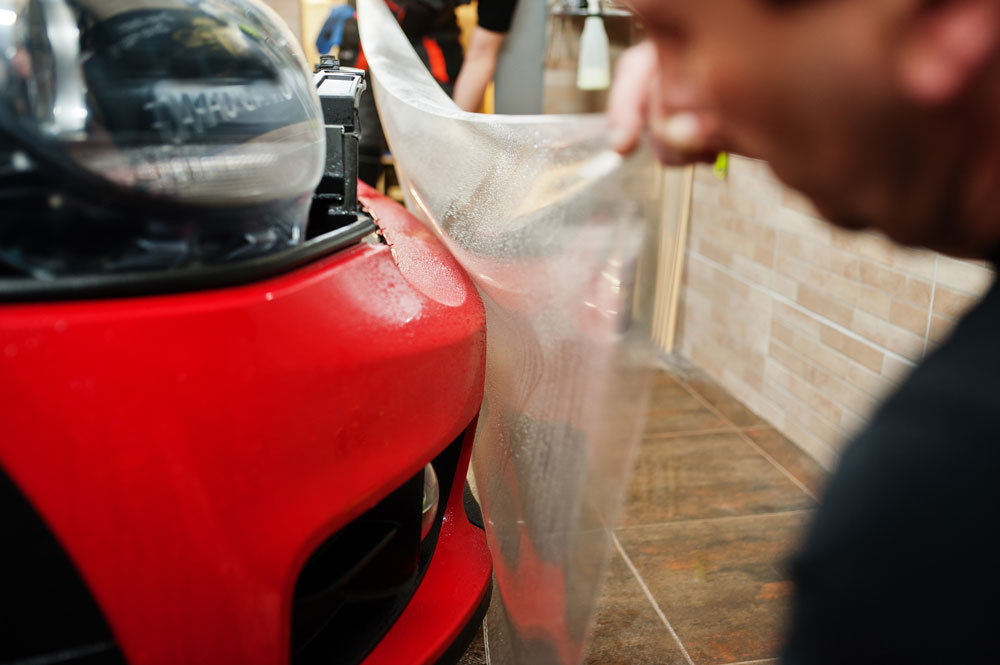
Winter in Wilmington, MA, can be rough on vehicles. Between freezing temps and frequent road treatments, your car’s paint ends up taking a beating. Road salt, slush, and loose gravel are just some of the things waiting to scratch or eat away at that shiny finish. If your car spends most of the winter parked outside or driving through snow-covered streets, it needs an extra layer of defense.
That’s where protection film for paint starts to shine. It’s a smart way to give your car a fighting chance against winter’s wear and tear. Rather than fixing damage after it happens, this film adds a durable barrier upfront. It guards your hood, bumpers, side mirrors, and door edges—the places most likely to get chipped or scraped while you try to get through the season.
Understanding Paint Protection Film
Winter paint protection film is a clear, flexible layer that sticks right onto your car’s surface. Think of it like a phone screen protector, but for your vehicle. Unlike waxes or sealants, which wash away over time, this film stays firmly in place and helps shield the paint from physical wear, road debris, and chemical buildup.
This material is designed to be both strong and nearly invisible. Most people won’t even know it’s there. Yet, it does a lot of work in the background. The film bends with your car’s curves and holds strong through cold, damp conditions. When installed the right way, it won’t bubble, haze, or peel. You keep your color and gloss, without the added risk of scratches and chips from road junk.
Some reasons drivers choose paint protection film:
- Blocks winter salt from settling directly onto exposed paint
- Absorbs the impact of small stones and sand kicked up from the road
- Helps prevent scratches from slushy snow brushes or car wash wipes
- Keeps door edges, handles, and side mirrors looking clean longer
- Holds up through snow, sleet, and slick road grime
Instead of repainting a bumper at the end of each season, car owners are turning to paint protection film as a way to prevent the damage in the first place. It’s a practical solution for anyone who wants to keep their vehicle looking newer, longer—especially when winter doesn’t give you many chances to avoid messy roads.
Winter Hazards To Your Car’s Paint
Once fall wraps up, the roads in Wilmington start to change fast. By late October, salt crews are prepping for early frost. And once the snow starts falling, your car is up against a constant stream of road treatments and grit—none of which are friendly to paint.
Here are some of the biggest winter threats to your car’s finish:
- Salt and brine treatments – Salt keeps roads safer, but it sticks to your car and eats away at unprotected paint. Once it seeps into chips or scratches, corrosion can start.
- Road gravel and grit – Crews often spread a mix of salt, sand, or small stones to help with traction. These bits get kicked up by other cars and leave tiny dings on your front end.
- Slush and ice chunks – These clumps collect under your fenders and then fall off as you drive. When they break away, they can take paint chips with them.
- Frozen tools and gear – Snow scrapers with rough edges or dirty gloves can scratch surfaces when you’re brushing off ice in a rush.
- Changes in temperature – Paint expands and contracts with shifts in temperature, which can weaken areas already stressed by chips or cracks.
If you’ve ever driven behind a plow or been stuck in a line of traffic on a snow-covered road, you know how tough winter driving can be on your vehicle. One small example—parking at the grocery store on a snowy day and finding your car covered in slush mixed with salt and grime. You could leave it to freeze or risk banging it off with a snow brush. Either choice runs the risk of leaving a mark.
These hazards might seem small at first, but add them up, and you’ve got a season’s worth of wear on your car. Paint protection film acts like a winter jacket for your paint—it gives you breathing room while everything else tries to rough it up.
Benefits Of Paint Protection Film In Winter
When the cold season hits the Boston area, cars face nonstop exposure to rough conditions. The roads turn gritty, parking lots become icy, and suddenly your vehicle takes on more wear than you’d expect. Paint protection film helps reduce that damage by acting like a clear shield, right where your car needs it the most.
This layer puts a physical barrier between your paint and the things that scratch or stain it. Whether you’re driving through a fresh snowstorm or pulling out of a slushy driveway, that winter paint protection helps reduce direct contact with corrosive materials like road salt and melting agents. It keeps the paint underneath in better shape through freezing days and messy commutes.
Here’s why investing in winter paint protection is a smart winter move:
- It resists peeling and cracking, even with large temperature swings
- Snowy buildup wipes off easier without dragging contaminants across the paint
- Maintains a smoother surface, which makes regular washes more effective
- Works on high-impact zones like bumpers, hood edges, and side skirts
- Can reduce costly paint repairs caused by salt-induced rust over time
Take everyday driving, for example. You head out in the morning, hit a patch of slush tossed up by a truck ahead, and get home to find your lower doors coated in salt. With no protection, every wipe or wash risks wearing the clear coat. A protection film takes the damage instead and bounces back better after each snowy drive.
Having that extra layer really makes a difference. It lets your paint do its job, while the film absorbs most of the punishment that comes with New England winters.
Professional Installation And Maintenance Tips
For paint protection film to work the way it’s supposed to, you need experienced hands to put it on. That matters more than people realize, especially during cold seasons when any air gap or wrinkle can open the door to moisture buildup, peeling, or yellowing.
A proper install follows the body lines, hugs the surface, and looks nearly invisible once it’s set. A skilled installer knows how to work around tough areas—curves, corners, exposed edges—so that snow, ice, and sand don’t find their way underneath. They’ll also select the right type of film for your daily use and local road conditions.
Once your film is installed, you should follow some basic steps to make it last through winter and beyond:
- Stick to gentle car washes during freezing months. Hand-rinsing with lukewarm water works well.
- Avoid stiff brushes or cloths with heavy grit. These can scratch the film or break the seals at the edges.
- Keep an eye on build-up around common trouble areas like fenders or behind wheels.
- Don’t use strong solvents or de-icing sprays near the film unless told it’s safe.
- Use your defroster instead of scraping aggressively when there’s ice over the hood or mirrors.
Keeping it simple goes a long way. Most protection films don’t need fancy treatments, just some seasonal care and sensible cleaning habits. When looked after, they hold up for years—even through repeat winters.
Shield Your Car This Winter
Every year, winter in Wilmington chips away at paint jobs. Whether it’s the messy mix of ice and rock salt or the sudden frigid snaps, your vehicle faces daily threats that don’t give you much notice. That’s why building up that surface-level defense before the first major storm hits can really pay off.
Paint protection film is one of the most reliable ways to do that. It helps your car age slower, look cleaner, and take on harsh elements with way less stress. It might not be the first thing you think about when the cold rolls in, but once snow starts falling and the roads start crunching under your tires, it’ll be the layer you’re glad is there.
If you care about how your vehicle handles winter—or just hate seeing your paint job fade year after year—it’s worth giving yourself that edge. There’s no controlling the roads, but you can control how your car faces them.
Winter roads bring a mix of challenges for your vehicle’s paint. By choosing protection film for paint, you can help your car stay in great shape through harsh conditions without compromising its appearance. Contact Wrap Solutions in Wilmington to help you drive through the season with confidence and a clean look that lasts.






